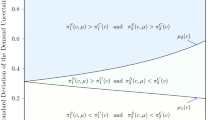Abstract.
This paper analyzes the formation of cartels of buyers and sellers in a simple model of trade inspired by Rubinstein and Wolinsky's (1990) bargaining model. When cartels are formed only on one side of the market, there is at most one stable cartel size. When cartels are formed sequentially on the two sides of the market, there is also at most one stable cartel configuration. Under bilateral collusion, buyers and sellers form cartels of equal sizes, and the cartels formed are smaller than under unilateral collusion. Both the buyers' and sellers' cartels choose to exclude only one trader from the market. This result suggests that there are limits to bilateral collusion, and that the threat of collusion on one side of the market does not lead to increased collusion on the other side.
Similar content being viewed by others
Author information
Authors and Affiliations
Rights and permissions
About this article
Cite this article
Bloch, F., Ghosal, S. Buyers' and sellers' cartels on markets with indivisible goods. Rev Econ Design 5, 129–147 (2000). https://doi.org/10.1007/s100580000018
Issue Date:
DOI: https://doi.org/10.1007/s100580000018




